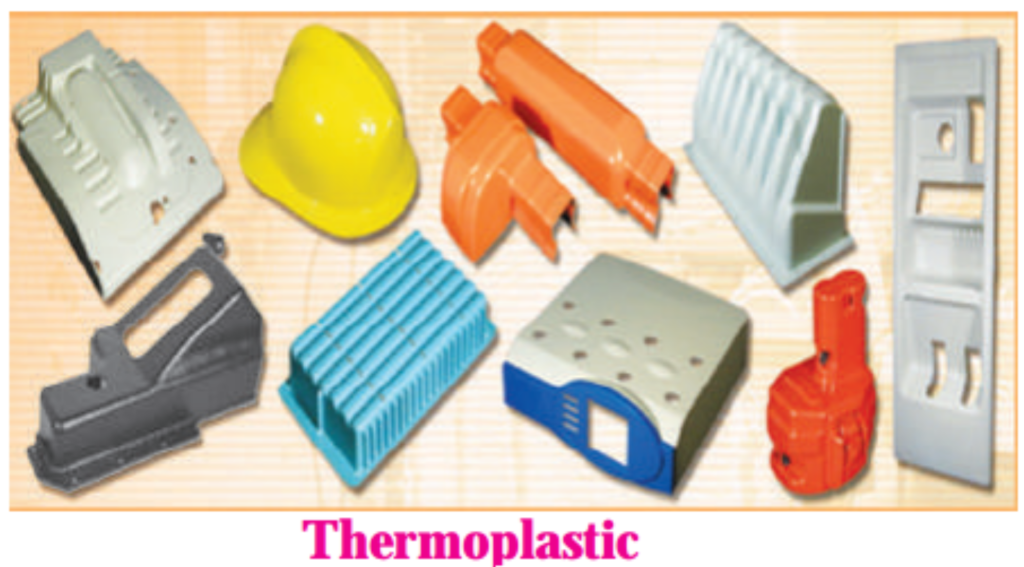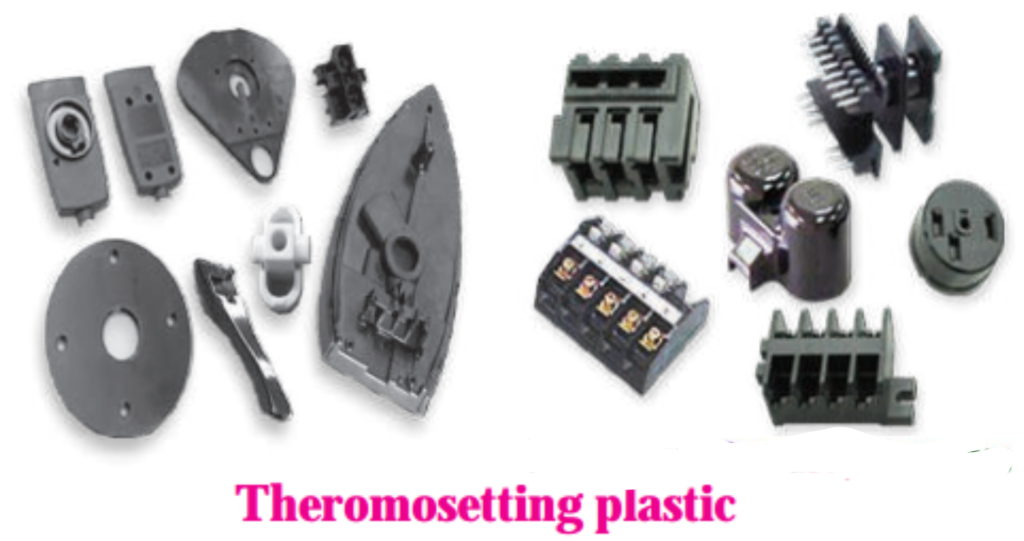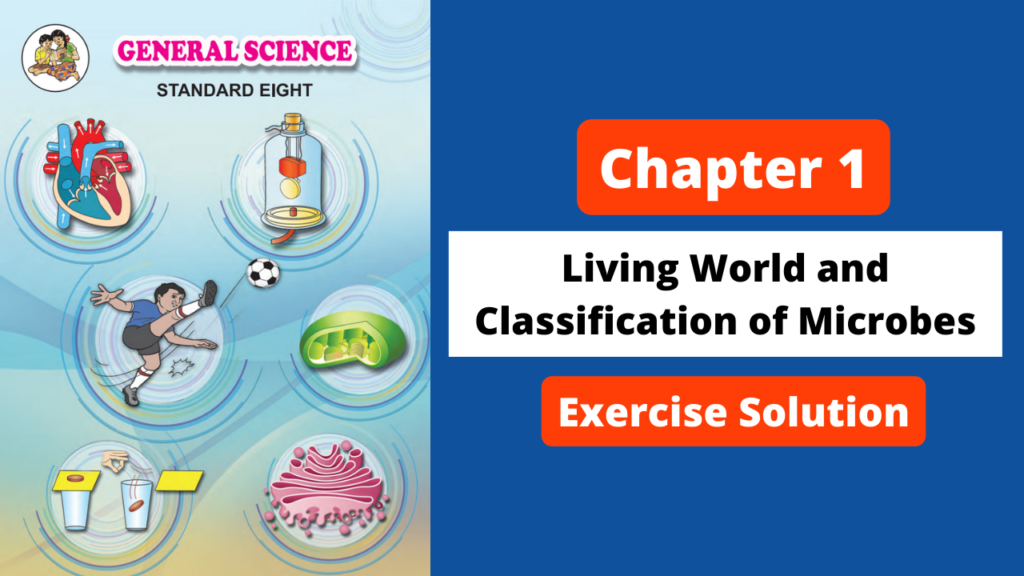
1. Try to find it:
a. Plastic shows …………. property, hence it can be moulded to any shape.
Answer:
Plastic shows plasticity property, hence it can be moulded to any shape.
b. Motor cars are coated with ……… .
Answer:
Motor cars are coated with Teflon.
c. Thermocol melts at ………… °C.
Answer:
Thermocol melts at more than 100 °C (it is about 240 °C).
d. …………….. glass dissolves in water.
Answer:
Alkali silicate or water glass dissolves in water.
2. Who is my partner?
| Column ‘A’ | Column ‘B’ |
| 1. Lead glass | a. Plates |
| 2. Bakelite | b. Mattresses |
| 3. Thermocol | c. Electric bulb |
| 4. Optic glass | d. Electric switch |
| 5. Polypropylene | e. Lens |
Answer:
| Column ‘A’ | Column ‘B’ |
| 1. Lead glass | c. Electric bulb |
| 2. Bakelite | d. Electric switch |
| 3. Thermocol | a. Plates |
| 4. Optic glass | e. Lens |
| 5. Polypropylene | b. Mattresses |
3. Answer the following.
a. Thermocol is produced from which material?
Answer:
Thermocol is made from polystyrene which is also a complex thermoplastic substance.
b. Write uses of PVC.
Answer:
PVC or Polyvinyl chloride is used for making bottles, raincoat, pipes, handbags, shoes, electric cable insulation, furniture, ropes, toys, etc.
c. Write the natural or man-made raw material of the following items.
Mattress, beaker, bangle, chair, gunny bag, broom, knife, pen.
Answer:
| Items | Natural raw material | Man-made raw materials |
| Mattress | Cotton, Coir (Jute fibres) | Polypropylene |
| Beaker | ___ | Glass (Silicate or borosilicate glass) |
| Bangle | Gold, silver, lac, copper | Plastic, Glass |
| Chair | Wood | Plastic (PVC) |
| Gunny bag | Jute, cotton | Plastic (PVC) |
| Broom | Plant fibres | Plastic fibres (PVC) |
| Knife | Metals such as iron | Plastic |
| Pen | Metals | Plastic |
d. Which are the main ingredients of glass?
Answer:
The main ingredients of glass are sand and silica.
e. How the plastic is produced?
Answer:
- Plastics are derived from natural materials such as natural gas, oil, coal, minerals and plants.
- The first synthetic plastics were i derived from cellulose, a substance found in plants and trees. This cellulose was heated with chemicals and resulted in a plastic like material.
- In modern times, the different raw materials are used for making plastics, but most plastics are made from the hydrocarbons present in the natural gas, oil and coal.
- Plastics are simply chains of like molecules linked together. These chains are called polymers. Thus, many plastics begin with “poly,” such as polyethylene, polystyrene and polypropylene.
- These polymers are made of carbon and hydrogen and sometimes oxygen, nitrogen, sulphur, chlorine, fluorine, phosphorous or silicon.
- Plastic is produced in factories by suitable chemical reactions.

4. Distinguish between.
a. Man-made material and natural material
Answer:
| Man-made material | Natural material |
| 1. The man-made materials are obtained from processes in scientific laboratory. | 1. Natural materials are obtained from nature. |
| 2. Man-made materials are subjected to rigorous processing to alter the material for serving the intended purpose. | 2. Natural materials are subjected to less treatment and processing. |
| 3. Man-made materials are typically much more durable having a very long lifespan. | 3. Natural materials have shorter lifespan, because these materials were once alive and so gradually perish over time. |
| 4. Maintaining man-made materials require less care and attention. | 4. Maintaining natural materials requires lots of care and continuous attention. |
| 5. Man-made materials can have a negative environmental impact because they are not sustainable. E.g. Glass, plastic, Thermocol, soil, metals, rubber. | 5. Natural materials do not have a negative environmental impact because they can be degraded easily. E.g. Cotton, silk, wood. |
b. Thermoplastic and Thermosetting plastic:
Answer:
| Thermoplastic | Thermosetting plastic |
| 1. The plastic that can be moulded as per our wish is called thermoplastic. | 1. The plastic in which a specific shape is given with the help of mould and this shape cannot be changed again on heating is called thermosetting plastic. |
| 2. Thermoplastic substances can be recycled and reused. E.g. PVC – Polyvinyl chloride, PS – Polystyrene, PE – Polyethylene and PP – Polypropylene are types of thermoplastics. | 2. Thermosetting plastic cannot be reused again. E.g. Bakelite, Melamine, Polyurethane and polyster are the types of thermosetting plastics. |
5. Answer the following in your own words.
a. Explain the effect of following materials on environment and human health.
1. Plastic
2. Glass.
3. Thermocol.
Answer:
1. Plastic:
- Plastic is non-degradable substance. Hence if thrown in any ecosystem, it remains unchanged for many years.
- It is one of the worst environmental pollutants as its disposal is a major problem.
- If thrown in water bodies, it affects the aquatic animals. Many of turtles mistake it for algae and eat the plastic. Eventually such animals die due to choking.
- In terrestrial environment, the grazing animals like cattle are affected due to plastic.
- If burnt it emits very toxic gases.
- In landfill sites, it remains unchanged for thousands of years.
2. Glass:
- The glass production is carried out at high temperatures of about 1500 °C. This burning emits many hazardous gases like sulphur dioxide, nitrogen dioxide, carbon dioxide. These gases cause the greenhouse effect.
- Moreover, glass being non-degradable, cause pollution.
- If broken glass pieces or any waste glass material is disposed into aquatic environment, it affects animals and plants.
- Similarly, glass pieces block the drainages.
- The waste glass thrown anywhere cause injury to terrestrial fauna.
3. Thermocol:
- Thermocol contains carcinogenic ingredients in the form of styrene. If there is prolonged contact with thermocol, there is a possibility of blood cancer like leukemia and lymphoma.
- Thermocol is non-degradable. It cannot be degraded into harmless substances easily.
- If it is burnt for destruction, it releases toxic gases in atmosphere.
- The plates and cups used for food, water, tea, etc. are made up of thermocol. This may affect the health. Reheating the food kept in thermocol releases styrene. This styrene may dissolve in that food, causing health problems like cancer.
b. Which measures will you arrange to minimize the environmental problems arising due to non-degradable plastic?
Answer:
- The use of plastic should be minimum. Reducing the consumption, reusing the same plastic again and again, recycling the used plastic and making some new products from the used plastic are some of the measures that can be adopted.
- There are attempts to use plastic in making roads. Therefore, plastic is bought with good price at some places.
- Therefore, instead of disposing of it anywhere, it should be collected and sold in best possible way.
- The better alternatives for plastic should be adopted.
- The awareness programmes about misuse of plastic should be arranged so that common man can understand the dangers of using plastic.
6. Write short notes.
a. Glass production:
Answer:
The general preparation of the glass is as follows:
- Mixture of sand, soda, lime and small quantity of magnesium oxide is heated in furnace.
- At 1700 °C sand or silicon dioxide melts.
- To make the mixture melt at lesser temperature, pieces of discarded glasses are added to it.
- This addition makes the mixture to melt at lesser temperature of 850 °C.
- When all the ingredients of mixture are liquified, then again it is heated up to 1500 °C.
- This heating is immediately followed by cooling.
- The sudden cooling causes the mixture to become homogeneous, amorphous and transparent instead of crystalline.
- For variety of glass types, different proportions of ingredients are used for heating.
b. Optic glass:
Answer:
- Optic glass or optical glass needs to be very clear and transparent as it is used in spectacles, lenses and other devices like microscopes.
- Optic glasses are produced from the mixture of sand, soda, limestone, barium oxide and boron.
c. Uses of plastic:
Answer:
Plastic, the man-made material is used in various forms in modern age. According to the type of plastic, its uses are different.

I. Thermoplastic materials are used for manufacturing following articles:
- Polyvinyl chloride or PVC is used to make bottles, raincoat, pipes, handbags,: shoes, electric cable insulation, furniture, ropes, toys, etc.
- Polystyrene is used in making thermo insulating parts of electric appliances like refrigerators, gears of machines, toys, protective coverings like covers of CD and DVD, etc.
- Polyethylene (PE) plastics are used for making milk bags, packing bags, flexible garden pipes, etc.
- Polypropylene (PP) is used in making parts of loudspeakers and vehicles, ropes, mattresses, laboratory appliances, etc.
II. Thermosetting plastic is used in the manufacturing of the following items:

- Bakelite for making cabinets of radio, T.V., telephones, electric switches, toys, plastic handles of cookers, etc.
- Melamine for making domestically useful items like cup – saucers, plates, tray, some spare parts of airplane engines, electric and sound insulating coverings, etc.
- Polyurethane in making surfing boards, small boats, furniture, seats in vehicles, etc.
- Polyester in fibreglass, toners of laser printers, textile industry, etc.


